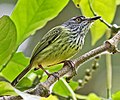| Todirostrum | |
|---|---|

| |
| Common tody-flycatcher (Todirostrum cinereum) | |
| Scientific classification | |
| Domain: | Eukaryota |
| Kingdom: | Animalia |
| Phylum: | Chordata |
| Class: | Aves |
| Order: | Passeriformes |
| Family: | Tyrannidae |
| Genus: | Todirostrum Lesson, 1831 |
| Type species | |
| Todus cinereus Linnaeus, 1766 | |
| Species | |
|
see text | |
Todirostrum is a genus of Neotropical birds in the New World flycatcher family Tyrannidae.
Taxonomy and species list
The genus Todirostrum was erected in 1831 by the French naturalist René Lesson. The type species was designated as the common tody-flycatcher by George Robert Gray in 1840. The name combines the genus Todus introduced by Mathurin Jacques Brisson in 1760 with the Latin rostrum meaning "bill".
It contains the following seven species:
| Image | Name | Common name | Distribution |
|---|---|---|---|
 |
Todirostrum maculatum | Spotted tody-flycatcher | Bolivia, Brazil, Colombia, Ecuador, French Guiana, Guyana, Peru, Suriname, Trinidad and Tobago, and Venezuela |
 |
Todirostrum poliocephalum | Yellow-lored tody-flycatcher or grey-headed tody-flycatcher | Brazil, occurring from Southern Bahia southwards to Santa Catarina |
 |
Todirostrum viridanum | Maracaibo tody-flycatcher | Venezuela |
 |
Todirostrum nigriceps | Black-headed tody-flycatcher | Colombia, Costa Rica, Ecuador, Panama, and Venezuela |
 |
Todirostrum pictum | Painted tody-flycatcher | eastern-southeastern Venezuela and the northeastern states of Brazil of the Amazon Basin |
 |
Todirostrum cinereum | Common tody-flycatcher or black-fronted tody-flycatcher | southern Mexico to northwestern Peru, eastern Bolivia and southern Brazil. |
 |
Todirostrum chrysocrotaphum | Yellow-browed tody-flycatcher | southern Amazon Basin of Brazil, also Amazonian Colombia, Ecuador, Peru, and Bolivia |
References
- Lesson, René (1831). Traité d'Ornithologie, ou Tableau Méthodique (in French). Paris: F.G. Levrault. p. 384 (livraison 5). Published in 8 livraisons between 1830 and 1831. For dates see: Dickinson, E.C.; Overstreet, L.K.; Dowsett, R.J.; Bruce, M.D. (2011). Priority! The Dating of Scientific Names in Ornithology: a Directory to the literature and its reviewers. Northampton, UK: Aves Press. p. 119. ISBN 978-0-9568611-1-5.
- Gray, George Robert (1840). A List of the Genera of Birds : with an Indication of the Typical Species of Each Genus. London: R. and J.E. Taylor. p. 31.
- Traylor, Melvin A. Jr, ed. (1979). Check-List of Birds of the World. Vol. 8. Cambridge, Massachusetts: Museum of Comparative Zoology. p. 87.
- Jobling, James A. (2010). The Helm Dictionary of Scientific Bird Names. London: Christopher Helm. p. 387. ISBN 978-1-4081-2501-4.
- Gill, Frank; Donsker, David; Rasmussen, Pamela, eds. (2020). "Tyrant flycatchers". IOC World Bird List Version 10.2. International Ornithologists' Union. Retrieved 29 November 2020.
| Taxon identifiers | |
|---|---|
| Todirostrum | |
This article about a tyrant flycatcher is a stub. You can help Misplaced Pages by expanding it. |
